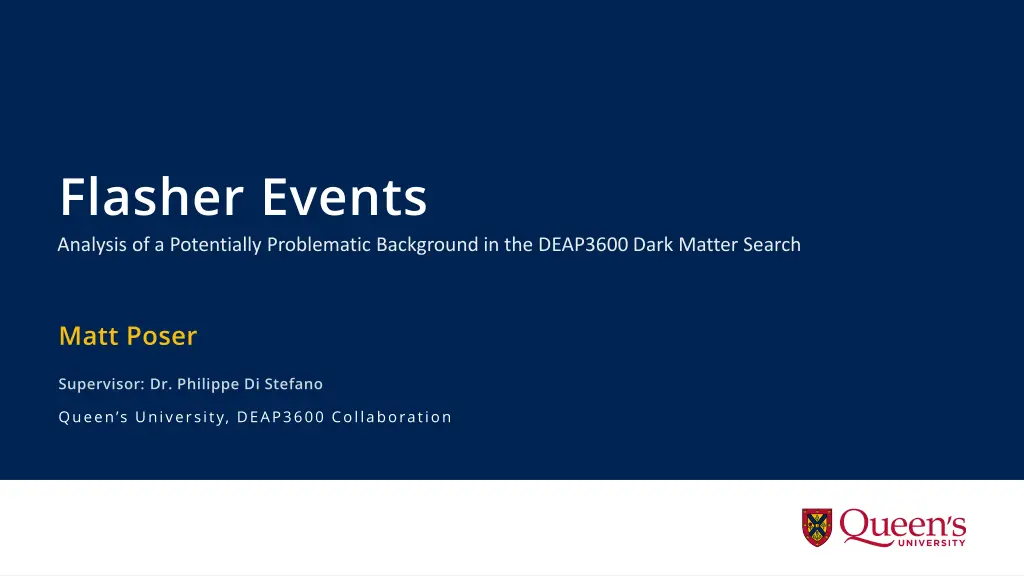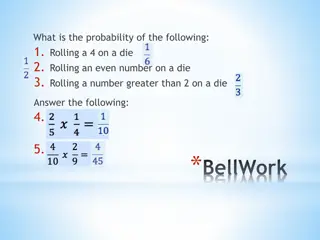
Dark Matter Search in DEAP3600: Understanding Flasher Events
Explore the analysis of potentially problematic background in the DEAP3600 dark matter search, focusing on Flasher Events and the importance of filtering them out to distinguish them from dark matter WIMP events. Learn about the DEAP experiment, key concepts like PhotoMultiplier Tubes (PMTs), and the goal of minimizing background to enhance detection accuracy.
Download Presentation

Please find below an Image/Link to download the presentation.
The content on the website is provided AS IS for your information and personal use only. It may not be sold, licensed, or shared on other websites without obtaining consent from the author. If you encounter any issues during the download, it is possible that the publisher has removed the file from their server.
You are allowed to download the files provided on this website for personal or commercial use, subject to the condition that they are used lawfully. All files are the property of their respective owners.
The content on the website is provided AS IS for your information and personal use only. It may not be sold, licensed, or shared on other websites without obtaining consent from the author.
E N D
Presentation Transcript
Flasher Events Analysis of a Potentially Problematic Background in the DEAP3600 Dark Matter Search Matt Poser Supervisor: Dr. Philippe Di Stefano Queen s University, DEAP3600 Collaboration
Important Concepts PhotoMultiplier Tubes (PMTs) Scintillation Flash of light See the light Evidence of particle Photoelectric effect [1] interactions Electrical signal 1
The DEAP Experiment Looking for dark matter as W.I.M.P.s 2.07 km underground to filter out strongly interacting particles 3600 kg liquid argon PMTs inside, turn scintillation light into electrical signals From particle interaction to data: Interaction Scintillation (light) PMTs see Electrical Signals Figure 1- The DEAP 3600 dark matter detector. Obtained from DEAP collaboration paper: Design and Construction of the DEAP-3600 Dark Matter Detector [2] Converted to code! 2
What is a Background? Backgrounds are important in particle detection Easy concept to understand, needle in a haystack analogy [3] Dark matter WIMP events are our needle Backgrounds are pieces of hay that look like the needle Analysis Goal: Our job is to filter out the events which may look like dark matter WIMP events, ie: as much background as possible 3
Flasher Events A special kind of event, not caused by particle interaction A single PMT emits a BIG signal Rest of the PMTs light up, smaller signal Specific order, visual look What do we know? They are consistent in their characteristics And Figure 2- Flasher Events depicted using animation software Can be defined visually 4
Background Flasher Events We want to cut out flasher events Flashers have the chance to continue into subsequent lower energy flasher events These subsequent low energy events could look similar to WIMP events Why do we want to cut them out? If we can pick flashers out of data, we can treat the following events more carefully, filter out our background events The following events could be a problem, may look like the WIMP events we are looking for! Flasher event First event after Second event after 5
How Were Cuts Made? Make cuts based on these characteristics Collect many flashers Identify unique characteristics 1. Events before and after 2. Event specific variables 6
Looking Before and After Time difference between sequential events Translates to event rate Sampled and plotted t for events before & after flashers Flashers had a clear graphical trend Tested against random data, was trend significant? 7
Notice anything different? The graphical trend seen in flasher events differs from random data in the same file. The trend may be a unique characteristic to flasher events, could be used as a cut! 10
Event Variables We wanted to find quantitative traits How is DEAP data stored for single events? Crowd of people analogy Person #4 #4 Event Person #1 #1 Person #3 #3 Event Event Person #2 #2 Event . . . . . . Shoe Color Energy Event Columns are events, rows are event attributes (ntp variables) Blue 2000 Red 80000 Green 5600 Grey 13000 Shirt Style Location Event Long Sleeve Sleeveless Jersey (0,0,0) T-Shirt (30, 40, -5) (20, 90, 15) (30, 10, -50) Gather our flasher events up, look at each row to find commonalities Number of PMTs Blonde 255 Hair Color Turned on Brown 235 Black 240 Red 239 Making selections becomes simple: cut out events where row contents are different than the flasher events Height Time of Event 5 7 12:34:59 5 8 4:07:01 5 9 2:44:09 5 4 21:17:38 . . . . . . 11
Cutting Out Flasher Events This is exactly what we want to do for flashers Looking for commonalities when plotting Events must pass all of the following cuts: found preliminary cuts between candidates Above energy of 2000 qPE (unit of energy measurement), Ignite at least 210 PMTs, Have no PMTs ignited by muons, Have an elapsed event time of 15 microseconds or less, Have less than 900 qPE of charge from the PMTs in the neck of the detector, Have the event be tracked to a distance of at least 70cm away from the center of the detector Tested cuts on the files containing original flasher events, 79% success rate (53/67 events) 12
Optimizing, Filtering Good starting point, but we want 100% ! Cuts need to be tweaked, made stricter. Iterative process Testing on Vacuum & LAr data Once good success has been reached with ntp cuts, use a secondary filter End Goal: To make a filter that picks out flasher events from data with confidence, and only picks out flashers! 13
References & Readings [1] Analytical and Measuring Instruments. Accessed: Jul. 31, 2024. [Online]. Available: https://www.ssi.shimadzu.com/service-support/faq/uv-vis/instrument-design/9/index.html Shimazdu North America, How does a photomultiplier tube work? Shimadzu North America, [2] p. 70. Accessed: Jul. 30, 2024. [Online]. Available: https://www.snolab.ca/deap/private/TWiki/pub/Main/PaperOverviewEntry0/view.pdf P.-A. Amaudruz et al., Design and Construction of the DEAP-3600 Dark Matter Detector, Dec. 2017, [3] analytics workshop, SNOLAB, Apr. 25, 2016. Accessed: Jul. 31, 2024. [Online]. Available: https://www.snolab.ca/deap/private/TWiki/pub/Main/TPMyTalks/DEAPDataWrangling.pdf Dr. Tina Pollmann for the DEAP collaboration, DEAP Data Wrangling, presented at the Data






















